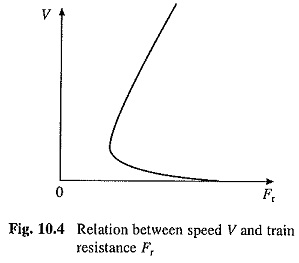Nature of Traction Load:
Nature of Traction Load describes as when the train runs at a constant velocity on level track, a number of frictional forces oppose its motion. The friction at bearings, guides etc. is classified as Internal Friction.
The rolling friction between wheels and rails, and friction between wheel-flanges and rails is termed as External Friction.
A third category consists of air friction which is independent of weight of train but depends upon its size and shape, and velocity and relative direction of wind. All these frictional forces together are known as Train Resistance.
Variation of train resistance (Fr) with speed (V) is shown in Fig. 10.4; load torque vs speed curve will have similar nature. The train resistance (or load torque) can also be identified in terms of common classification of friction such as windage, viscous friction, coulomb friction and stiction (Fig. 2.6). Stiction has a large value and the influence of air friction, which varies as the square of speed, is quite prominent at high speeds.
When deciding torque requirements of driving motors, the torque components required to provide acceleration and to overcome gravity must also be considered.
Owing to large inertia, particularly of electric trains, accelerating torque forms major proportion of the total torque in accelerating range. Because of large values of stiction and accelerating torque, the torque requirement at start and during acceleration is much higher than the torque needed for running at the highest speed.
Therefore, only those drives which develop large torque from zero to the base speed are suitable for Nature of Traction Load application.
